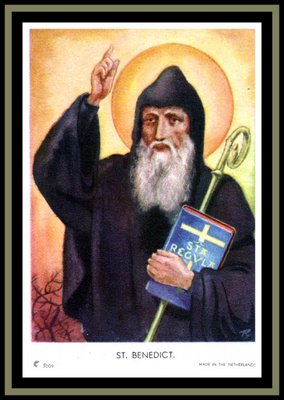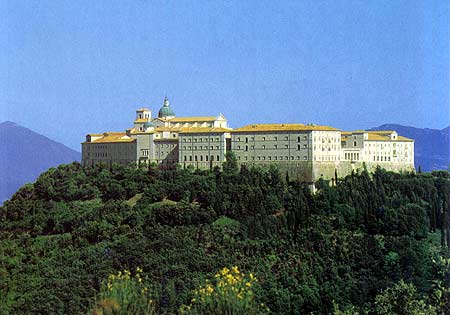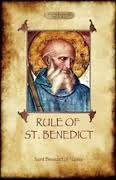
Summary, St Benedict, abbot: Born at Nursia (Umbria, Italy) about 480; died at Monte Cassino about 547. After studies in Rome he became a hermit at Subiaco, where many sought his counsel, and later founded the monastery at Monte Cassino. Noted for his widely influential monastic rule, combining work and prayer, and for his charity and moderation.
 St Benedict, founder of Western monasticism and author of the Rule which gave monasticism its constitution, exercised a fundamental influence on the development of European civilisation and culture. Because of this, in 1964, Pope Paul VI named him patron saint of Europe.
St Benedict, founder of Western monasticism and author of the Rule which gave monasticism its constitution, exercised a fundamental influence on the development of European civilisation and culture. Because of this, in 1964, Pope Paul VI named him patron saint of Europe.
Patrick Duffy tells his story.
Early Life
St. Benedict was born, a twin with St Scholastica, into a wealthy family at Nursia in east-central Umbria around the year 480. He went to school in Rome but, disturbed by the moral laxity of other students in Rome, he left before completing his studies. Seeking peace and quiet he withdrew to Subiaco situated in the mountains about forty miles from Rome. Here he met a monk called Romanus who helped him in his first steps as a hermit.
Overcoming Temptations
At Subiaco Benedict spent three years in a cave where he “underwent the three fundamental temptations that all human beings face: self-affirmation and the desire to place oneself at the centre, … sensuality, … and anger and revenge” (Pope Benedict XVI). Only by overcoming these temptations would he be able find the right words to give others in their situations of need.
First Monastery at Subiaco
Soon disciples joined him and he became the leader of a monastic community at Subiaco. Some monks there were unhappy with Benedict’s strict discipline and put poison in his wine. When they brought it to Benedict to drink, he blessed it and the glass miraculously broke. “God forgive you,” he exclaimed, and he went off again to the wilderness.
Maur and Placidus
More monks came to Subiaco and Benedict had twelve small monasteries with twelve in each one in that area. Some Roman senators came and left their sons with Benedict for education. Some of these turned out to be his most faithful disciples, St Maur and St Placid. The story of Maur rescuing Placid from drowning in the lake of Subiaco is told in Gregory, Dialogues II,7 and in artworks and mosaics. Placid was for some centuries regarded as the patron of Benedictine novices. Others, including a local priest, became envious and spread slander about Benedict.
Second Foundation at Monte Cassino
 Around 529 Benedict left Subiaco for Monte Cassino, where he built a great abbey and lived till his death in 547. Scholars, like Mabillon and Muratori, have argued from ancient pictures and inscriptions that Benedict was a deacon, but not a priest. From St Gregory’s account of his life in the Dialogues, it is clear that he preached in the neighbouring areas and that he was generous to the needy.
Around 529 Benedict left Subiaco for Monte Cassino, where he built a great abbey and lived till his death in 547. Scholars, like Mabillon and Muratori, have argued from ancient pictures and inscriptions that Benedict was a deacon, but not a priest. From St Gregory’s account of his life in the Dialogues, it is clear that he preached in the neighbouring areas and that he was generous to the needy.
Significance of Monte Cassino
Pope Benedict XVI recently described the decision of his namesake St Benedict to locate his monastery on Monte Cassino as symbolic. Monte Cassino is, he said, “a height that dominates the surrounding plains and is visible from a distance”. “Monastic life,” the Pope continued, “has its raison d’etre in withdrawal and concealment, but a monastery also has a public role in the life of the Church and of society”.
Benedictine Monasteries in Ireland
Glenstal Abbey in Co Limerick (www.glenstal.org/) and Holy Cross Monastery, Rostrevor, Co. Down (www.benedictinemonks.co.uk), are two Benedictine monasteries in Ireland which strive to fulfil this ideal.
Benedict’s Twin Sister
 Scholastica became the first Benedictine nun and set up a nunnery at Plombaria, about five miles from Monte Cassino. Brother and sister used to meet once a year at a house some distance from his monastery. On his last visit Scholastica, sensing perhaps that the end was near for both of them, asked him to stay longer ‘to discuss the joys of heaven’. When he declined, she prayed God would come to her help. Almost immediately a storm blew up. Benedict and his fellow monks could not leave. Benedict said, “God forgive you, sister. What have you done?” She replied, “I asked a favour of you and you refused. I asked God and he has granted it.” They spent the night as she had wished. Three days later she died. Benedict himself seems to have died quite soon after that.
Scholastica became the first Benedictine nun and set up a nunnery at Plombaria, about five miles from Monte Cassino. Brother and sister used to meet once a year at a house some distance from his monastery. On his last visit Scholastica, sensing perhaps that the end was near for both of them, asked him to stay longer ‘to discuss the joys of heaven’. When he declined, she prayed God would come to her help. Almost immediately a storm blew up. Benedict and his fellow monks could not leave. Benedict said, “God forgive you, sister. What have you done?” She replied, “I asked a favour of you and you refused. I asked God and he has granted it.” They spent the night as she had wished. Three days later she died. Benedict himself seems to have died quite soon after that.
 The Rule of St Benedict
The Rule of St Benedict
The Rule of St Benedict is a book of 73 chapters describing the organisation of the life of monks living in community and striving by means of the common life, ascetic practice, prayer and work to experience a life of fellowship with God. Its tone and tenor can be summed up in the motto of the Benedictine Confederation PAX (“peace”) and the traditional adage ORA ET LABORA (“pray and work”). Benedict had a deep personal love of Jesus and his rule is Rule is wise, humane, tolerant and moderate. It stresses humility before God and each other. Its richness is that it fosters an understanding of the relational nature of human beings on their individual journeys to God. It provides for a spiritual father to support individual ascetic effort and spiritual growth.
Prayer and Love
Benedict seems to have lived his life immersed in an atmosphere of prayer and it was this prayer that made him alive to the concrete needs of his neighbours.
____________________________
******************************
Memorable Sayings for Today
Listen with the ear of your heart
~ St Benedict ~
“The devil is afraid of us when we pray and make sacrifices.
He is also afraid when we are humble and good.
He is especially afraid when we love Jesus very much.
He runs away when we make the Sign of the Cross
~ St Anthony, Abbot of the Desert~
******************************